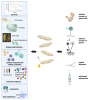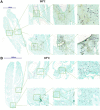Galleria mellonella Larvae as a Model for Investigating Fungal-Host Interactions
- PMID: 37746216
- PMCID: PMC10512315
- DOI: 10.3389/ffunb.2022.893494
Galleria mellonella Larvae as a Model for Investigating Fungal-Host Interactions
Abstract
Galleria mellonella larvae have become a widely accepted and utilised infection model due to the functional homology displayed between their immune response to infection and that observed in the mammalian innate immune response. Due to these similarities, comparable results to murine studies can be obtained using G. mellonella larvae in assessing the virulence of fungal pathogens and the in vivo toxicity or efficacy of anti-fungal agents. This coupled with their low cost, rapid generation of results, and lack of ethical/legal considerations make this model very attractive for analysis of host-pathogen interactions. The larvae of G. mellonella have successfully been utilised to analyse various fungal virulence factors including toxin and enzyme production in vivo providing in depth analysis of the processes involved in the establishment and progression of fungal pathogens (e.g., Candida spps, Aspergillus spp., Madurella mycetomatis, Mucormycetes, and Cryptococcus neoformans). A variety of experimental endpoints can be employed including analysis of fungal burdens, alterations in haemocyte density or sub-populations, melanisation, and characterisation of infection progression using proteomic, histological or imaging techniques. Proteomic analysis can provide insights into both sides of the host-pathogen interaction with each respective proteome being analysed independently following infection and extraction of haemolymph from the larvae. G. mellonella can also be employed for assessing the efficacy and toxicity of antifungal strategies at concentrations comparable to those used in mammals allowing for early stage investigation of novel compounds and combinations of established therapeutic agents. These numerous applications validate the model for examination of fungal infection and development of therapeutic approaches in vivo in compliance with the need to reduce animal models in biological research.
Keywords: Aspergillus; Candida; Cryptococcus; Galleria mellonella; fungal infection; in vivo; innate immunity.
Copyright © 2022 Curtis, Binder and Kavanagh.
Conflict of interest statement
The authors declare that the research was conducted in the absence of any commercial or financial relationships that could be construed as a potential conflict of interest.
Figures






Similar articles
-
The non-mammalian host Galleria mellonella can be used to study the virulence of the fungal pathogen Candida tropicalis and the efficacy of antifungal drugs during infection by this pathogenic yeast.Med Mycol. 2013 Jul;51(5):461-72. doi: 10.3109/13693786.2012.737031. Epub 2012 Nov 21. Med Mycol. 2013. PMID: 23170962
-
The Use of Galleria mellonella Larvae to Identify Novel Antimicrobial Agents against Fungal Species of Medical Interest.J Fungi (Basel). 2018 Sep 19;4(3):113. doi: 10.3390/jof4030113. J Fungi (Basel). 2018. PMID: 30235800 Free PMC article. Review.
-
Galleria mellonella: The Versatile Host for Drug Discovery, In Vivo Toxicity Testing and Characterising Host-Pathogen Interactions.Antibiotics (Basel). 2021 Dec 17;10(12):1545. doi: 10.3390/antibiotics10121545. Antibiotics (Basel). 2021. PMID: 34943757 Free PMC article. Review.
-
Galleria mellonella for the Evaluation of Antifungal Efficacy against Medically Important Fungi, a Narrative Review.Microorganisms. 2020 Mar 11;8(3):390. doi: 10.3390/microorganisms8030390. Microorganisms. 2020. PMID: 32168839 Free PMC article. Review.
-
Characterization of Aspergillus fumigatus secretome during sublethal infection of Galleria mellonella larvae.J Med Microbiol. 2024 Jun;73(6):001844. doi: 10.1099/jmm.0.001844. J Med Microbiol. 2024. PMID: 38836745 Free PMC article.
Cited by
-
Geraniol Potentiates the Effect of Fluconazole against Planktonic and Sessile Cells of Azole-Resistant Candida tropicalis: In Vitro and In Vivo Analyses.Pharmaceutics. 2024 Aug 9;16(8):1053. doi: 10.3390/pharmaceutics16081053. Pharmaceutics. 2024. PMID: 39204397 Free PMC article.
-
Powerful and Real-Time Quantification of Antifungal Efficacy against Triazole-Resistant and -Susceptible Aspergillus fumigatus Infections in Galleria mellonella by Longitudinal Bioluminescence Imaging.Microbiol Spectr. 2023 Aug 17;11(4):e0082523. doi: 10.1128/spectrum.00825-23. Epub 2023 Jul 19. Microbiol Spectr. 2023. PMID: 37466453 Free PMC article.
-
The Virtuous Galleria mellonella Model for Scientific Experimentation.Antibiotics (Basel). 2023 Mar 3;12(3):505. doi: 10.3390/antibiotics12030505. Antibiotics (Basel). 2023. PMID: 36978373 Free PMC article. Review.
-
Sunflower Oil and Cholesterol Nanoemulsion: A Novel Carrier for Micafungin to Combat Multi-Resistant Candida auris.Pathogens. 2024 Jun 28;13(7):549. doi: 10.3390/pathogens13070549. Pathogens. 2024. PMID: 39057777 Free PMC article.
-
Preclinical Models for Cryptococcosis of the CNS and Their Characterization Using In Vivo Imaging Techniques.J Fungi (Basel). 2024 Feb 12;10(2):146. doi: 10.3390/jof10020146. J Fungi (Basel). 2024. PMID: 38392818 Free PMC article. Review.
References
-
- Al Abdallah Q., Choe S., Campoli P., Baptista S., Gravelat F., Lee M., et al. . (2012). A conserved C-Terminal domain of the Aspergillus fumigatus developmental regulator MedA is required for nuclear localization, adhesion and virulence. PLoS ONE 7, e49959. 10.1371/journal.pone.0049959 - DOI - PMC - PubMed
-
- Astvad K., Meletiadis J., Whalley S., Arendrup M. (2017). Fluconazole pharmacokinetics in Galleria mellonella larvae and performance evaluation of a bioassay compared to liquid chromatography-tandem mass spectrometry for hemolymph specimens. Antimicrob. Agents Chemother. 61, e00895-17. 10.1128/AAC.00895-17 - DOI - PMC - PubMed
-
- Bergin D., Reeves E. P., Renwick J., Wientjes F. B., Kavanagh K. (2005). Superoxide production in haemocytes of Galleria mellonella – identification of proteins homologous to the NADPH oxidase complex of human neutrophils. Infect. Immun. 73, 4161–4173. 10.1128/IAI.73.7.4161-4170.2005 - DOI - PMC - PubMed
Publication types
LinkOut - more resources
Full Text Sources
Miscellaneous

